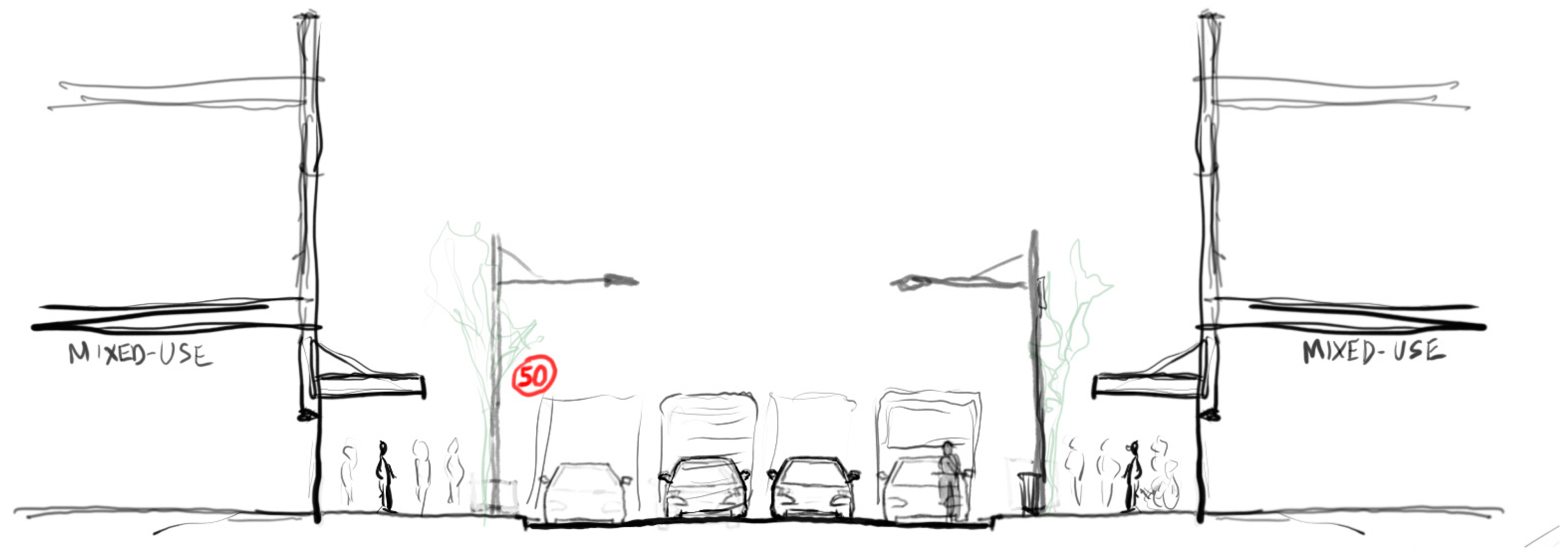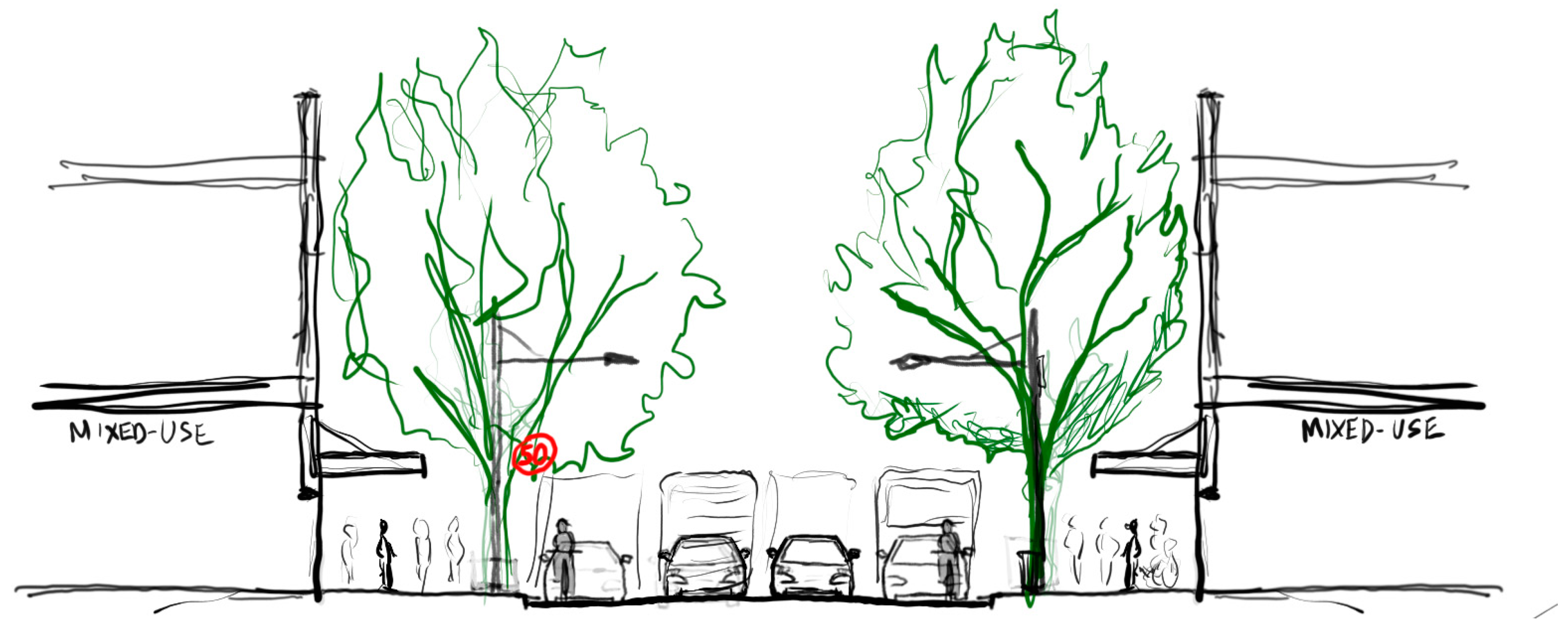Informing Streetscape Design with Citizen Perceptions of Safety and Place: An Immersive Virtual Environment E-Participation Method
Abstract
:1. Introduction
1.1. Safety and Place
1.2. Understanding Citizen Perceptions of Streetscapes
1.2.1. Visual Representation
1.2.2. Immersive Virtual Environments (IVEs)
1.2.3. 360-Degree Auditory Cues in Immersive Virtual Environments
1.3. Aim
2. Method
2.1. Identification of Specific Variables—Choosing Pedestrian-Oriented Place-Making and Safe System Treatments
2.2. Construction of Animated Digital 3D Parametric Street Model
2.2.1. 3D Digital Model Development
2.2.2. Game Engine Preparation
2.2.3. 360-Degree Video and Binaural Audio Output
2.3. Online Survey—Testing Perceptions of Street Types with Varied Parameters
2.3.1. Introduction, Explanatory Statement and Informed Consent
2.3.2. Demographic Questions
2.3.3. Scenario Introduction and Instructions
2.3.4. Randomised Scenarios with Associated Safety and Place Questions
2.3.5. Post Scenario Questions
2.4. Recruitment of Participants
2.5. General Estimating Equation (GEE) Ordinal Logistic Regression
3. Results
3.1. Responses
3.1.1. Response Rate
3.1.2. Gender Breakdown
3.1.3. Location of Participants
3.1.4. Age of Participants
3.1.5. Occupation of Participants
3.1.6. Transport Modes
3.2. Sample Survey Response
3.2.1. Sample of Revealed Preference Affect-Slider Results
3.2.2. Sample of Revealed Preference Affect-Grid Results
3.2.3. Sample of Stated Preference
4. Discussion
4.1. Key Methodological Insights
4.1.1. The Approach Garnered a Strong Level of Engagement
4.1.2. The Digital Survey (E-participation) Approach Resulted in Input from a Wide Range of Citizens
4.1.3. Using Immersive Virtual Environments (IVE) Allowed for Multiple Controlled Scenario Analysis
4.1.4. The IVEs Allowed for the Testing of Complex Dynamic Street Interactions
4.1.5. The Approach Allowed for the Quantification of Human Emotional and Perceptual Responses
4.2. Limitations
4.3. Suggested Further Research—What Next?
5. Conclusions
Author Contributions
Funding
Institutional Review Board Statement
Informed Consent Statement
Data Availability Statement
Acknowledgments
Conflicts of Interest
References
- Thomson, G.; Newton, P.; Newman, P. Urban Regeneration and Urban Fabrics in Australian Cities. J. Urban Regen. Renew. 2017, 10, 169–190. [Google Scholar]
- Transport for NSW. Future Transport 2056 Strategy; NSW Government: Sydney, Australia, 2018. Available online: https://future.transport.nsw.gov.au/sites/default/files/media/documents/2018/Future_Transport_2056_Strategy.pdf (accessed on 1 January 2023).
- Transport for NSW. Road Safety Plan 2021. NSW Government; NSW Government: Sydney, Australia, 2018. Available online: https://roadsafety.transport.nsw.gov.au/aboutthecentre/strategies/road-safety-plan-2021/index.html (accessed on 1 January 2023).
- Ewing, R.; Clemente, O. Measuring Urban Design: Metrics for Livable Places; Island Press: Washington, DC, USA, 2013; ISBN 978-1-61091-209-9. [Google Scholar]
- Hooi, E.; Pojani, D. Urban Design Quality and Walkability: An Audit of Suburban High Streets in an Australian City. J. Urban Des. 2019, 25, 155–179. [Google Scholar] [CrossRef]
- Zacharias, J. Pedestrian Behavior Pedestrian Behavior and Perception in Urban Walking Environments. J. Plan. Lit. 2001, 16, 3–18. [Google Scholar] [CrossRef]
- Souza, C.; Garrido, M.V.; Carmo, J.C. A Systematic Review of Normative Studies Using Images of Common Objects. Front. Psychol. 2020, 11, 573314. [Google Scholar] [CrossRef]
- Ewing, R.; Handy, S. Measuring the Unmeasurable: Urban Design Qualities Related to Walkability. J. Urban Des. 2009, 14, 65–84. [Google Scholar] [CrossRef]
- Moudon, A.V.; Lee, C. Walking and Bicycling: An Evaluation of Environmental Audit Instruments. Am. J. Health Promot. 2003, 18, 21–37. [Google Scholar] [CrossRef]
- Harvey, C.; Aultman-Hall, L.; Hurley, S.E.; Troy, A. Effects of Skeletal Streetscape Design on Perceived Safety. Landsc. Urban Plan. 2015, 142, 18–28. [Google Scholar] [CrossRef] [Green Version]
- Sarkar, C.; Webster, C.; Pryor, M.; Tang, D.; Melbourne, S.; Zhang, X.; Jianzheng, L. Exploring Associations between Urban Green, Street Design and Walking: Results from the Greater London Boroughs. Landsc. Urban Plan. 2015, 143, 112–125. [Google Scholar] [CrossRef]
- Berger, M.; Bill, R. Combining VR Visualization and Sonification for Immersive Exploration of Urban Noise Standards. Multimodal Technol. Interact. 2019, 3, 34. [Google Scholar] [CrossRef] [Green Version]
- Yu, T.; Behm, H.; Bill, R.; Kang, J. Validity of VR Technology on the Smartphone for the Study of Wind Park Soundscapes. ISPRS Int. J. Geo-Inf. 2018, 7, 152. [Google Scholar] [CrossRef] [Green Version]
- Joseph, A.; Browning, M.H.E.M.; Jiang, S. Using Immersive Virtual Environments (IVEs) to Conduct Environmental Design Research: A Primer and Decision Framework. HERD Health Environ. Res. Des. J. 2020, 13, 193758672092478. [Google Scholar] [CrossRef] [PubMed]
- Schnabel, M.A.; Kvan, T. Spatial Understanding in Immersive Virtual Environments. Int. J. Archit. Comput. 2003, 1, 435–448. [Google Scholar] [CrossRef]
- Bonnington, C. You Can Now Watch and Upload 360-Degree Videos on YouTube. Wired, 13 March; 2015.
- Nordahl, R.; Nilsson, N.C. Presence and Interactive Audio in Immersive Virtual Reality; Oxford Academic: Oxford, UK, 2014; p. 22. [Google Scholar]
- Schifferstein, H.N.J. The Perceived Importance of Sensory Modalities in Product Usage: A Study of Self-Reports. Acta Psychol. 2006, 121, 41–64. [Google Scholar] [CrossRef] [PubMed]
- Larsson, P.; Väljamäe, A.; Västfjäll, D.; Tajadura-Jiménez, A.; Kleiner, M. Auditory-Induced Presence in Mixed Reality Environments and Related Technology. In The Engineering of Mixed Reality Systems; Dubois, E., Gray, P., Nigay, L., Eds.; Human-Computer Interaction Series; Springer: London, UK, 2010; pp. 143–163. ISBN 978-1-84882-732-5. [Google Scholar]
- Lokki, T.; Grohn, M. Navigation with Auditory Cues in a Virtual Environment. IEEE Multimed. 2005, 12, 80–86. [Google Scholar] [CrossRef]
- Bernhard, M.; Grosse, K.; Wimmer, M. Bimodal Task-Facilitation in a Virtual Traffic Scenario through Spatialized Sound Rendering. ACM Trans. Appl. Percept. 2011, 8, 1–22. [Google Scholar] [CrossRef] [Green Version]
- Roads and Maritime Services, N.S.W. Traffic and Transport Technical Directions. Available online: https://www.rms.nsw.gov.au/business-industry/partners-suppliers/document-types/technical-directions/traffic-transport.html (accessed on 25 September 2020).
- Geuss, M.; Stefanucci, J.K.; Creem-Regehr, S.H.; Thompson, W.B. Effect of Viewing Plane on Perceived Distances in Real and Virtual Environments. J. Exp. Psychol. Hum. Percept. Perform. 2012, 38, 1242–1253. [Google Scholar] [CrossRef]
- Loomis, J.M.; Blascovich, J.J.; Beall, A.C. Immersive Virtual Environment Technology as a Basic Research Tool in Psychology. Behav. Res. Methods Instrum. Comput. 1999, 31, 557–564. [Google Scholar] [CrossRef] [Green Version]
- Renner, R.S.; Velichkovsky, B.M.; Helmert, J.R. The Perception of Egocentric Distances in Virtual Environments—A Review. ACM Comput. Surv. 2013, 46, 23–40. [Google Scholar] [CrossRef] [Green Version]
- Uggah, L.; Manaf, A.A. Overcoming the Uncanny Valley Theory in Digital Characters Based on Human Attitudes. Pertanika J. Soc. Sci. Humanit. 2015, 23, 13–22. [Google Scholar]
- Louviere, J.J.; Street, D.; Burgess, L.; Wasi, N.; Islam, T.; Marley, A.A. Modeling the Choices of Individual Decision-Makers by Combining Efficient Choice Experiment Designs with Extra Preference Information. J. Choice Model. 2008, 1, 128–164. [Google Scholar] [CrossRef] [Green Version]
- Betella, A.; Verschure, P.F.M.J. The Affective Slider: A Digital Self-Assessment Scale for the Measurement of Human Emotions. PLoS ONE 2016, 11, e0148037. [Google Scholar] [CrossRef] [PubMed] [Green Version]
- Laurans, G.; Desmet, P.M.A.; Hekkert, P. The Emotion Slider: A Self-Report Device for the Continuous Measurement of Emotion. In Proceedings of the 2009 3rd International Conference on Affective Computing and Intelligent Interaction and Workshops, Amsterdam, The Netherlands, 10–12 September 2009; pp. 1–6. [Google Scholar]
- Klimek, L.; Bergmann, K.-C.; Biedermann, T.; Bousquet, J.; Hellings, P.; Jung, K.; Merk, H.; Olze, H.; Schlenter, W.; Stock, P. Visual Analogue Scales (VAS): Measuring Instruments for the Documentation of Symptoms and Therapy Monitoring in Cases of Allergic Rhinitis in Everyday Health Care. Allergo J. Int. 2017, 26, 16–24. [Google Scholar] [CrossRef] [PubMed]
- Russell, J.A.; Weiss, A.; Mendelsohn, G.A. Affect Grid: A Single-Item Scale of Pleasure and Arousal. J. Personal. Soc. Psychol. 1989, 57, 493. [Google Scholar] [CrossRef]
- Toet, A.; Kaneko, D.; Ushiama, S.; Hoving, S.; de Kruijf, I.; Brouwer, A.-M.; Kallen, V.; van Erp, J.B.F. EmojiGrid: A 2D Pictorial Scale for the Assessment of Food Elicited Emotions. Front. Psychol. 2018, 9, 2396. [Google Scholar] [CrossRef] [PubMed] [Green Version]
- Witmer, B.G.; Singer, M.J. Measuring Presence in Virtual Environments: A Presence Questionnaire. Presence Teleoperators Virtual Environ. 1998, 7, 225–240. [Google Scholar] [CrossRef]
- White, M.; Langenheim, N. A Ladder-Truss of Citizen Participation: Re-Imagining Arnstein’s Ladder to Bridge between the Community and Sustainable Urban Design Outcomes. J. Des. Res. 2021, 19, 155–183. [Google Scholar] [CrossRef]





















| Prioritised Streetscape Table |
|---|
| Baseline control configuration: ‘Baseline’ (4 lanes of traffic @50 km/ph) [Figure 3] |
| Speed configuration: ‘Reduced speed’ 30 km/ph [Figure 4] |
| Distance separation configuration: ‘Parked car buffer’ (2 lanes of traffic) |
| Barrier separation configuration: ‘Barrier fence’ |
| Barrier separation configuration: ‘Increased tree canopy’ [Figure 5] |
| Barrier separation configuration: ‘Ground vegetation buffer’ [Figure 6] |
| Distance separation configuration: ‘Cycle lane’ (3 lanes of traffic) |
| Barrier separation configuration: ‘Less clutter’ |
| Distance separation configuration: ‘Widened footpath’ (3 lanes of traffic) |
| Crossing configuration: ‘Signalised crossing long-wait’ (non-pedestrian prioritised) |
| Crossing configuration: ‘Signalised crossing short-wait’ (pedestrian prioritised) |
| Crossing configuration: ‘Refuge island’ (non-pedestrian prioritised) (2 lanes of traffic) |
| Crossing configuration: ‘Wombat crossing’ (pedestrian prioritised) (2 lanes of traffic) [Figure 7] |
| Ranked Findings for ‘Would This Be a Good Place to Stop for Coffee?’ |
|
Disclaimer/Publisher’s Note: The statements, opinions and data contained in all publications are solely those of the individual author(s) and contributor(s) and not of MDPI and/or the editor(s). MDPI and/or the editor(s) disclaim responsibility for any injury to people or property resulting from any ideas, methods, instructions or products referred to in the content. |
© 2023 by the authors. Licensee MDPI, Basel, Switzerland. This article is an open access article distributed under the terms and conditions of the Creative Commons Attribution (CC BY) license (https://creativecommons.org/licenses/by/4.0/).
Share and Cite
White, M.; Langenheim, N.; Yang, T.; Paay, J. Informing Streetscape Design with Citizen Perceptions of Safety and Place: An Immersive Virtual Environment E-Participation Method. Int. J. Environ. Res. Public Health 2023, 20, 1341. https://doi.org/10.3390/ijerph20021341
White M, Langenheim N, Yang T, Paay J. Informing Streetscape Design with Citizen Perceptions of Safety and Place: An Immersive Virtual Environment E-Participation Method. International Journal of Environmental Research and Public Health. 2023; 20(2):1341. https://doi.org/10.3390/ijerph20021341
Chicago/Turabian StyleWhite, Marcus, Nano Langenheim, Tianyi Yang, and Jeni Paay. 2023. "Informing Streetscape Design with Citizen Perceptions of Safety and Place: An Immersive Virtual Environment E-Participation Method" International Journal of Environmental Research and Public Health 20, no. 2: 1341. https://doi.org/10.3390/ijerph20021341
APA StyleWhite, M., Langenheim, N., Yang, T., & Paay, J. (2023). Informing Streetscape Design with Citizen Perceptions of Safety and Place: An Immersive Virtual Environment E-Participation Method. International Journal of Environmental Research and Public Health, 20(2), 1341. https://doi.org/10.3390/ijerph20021341








